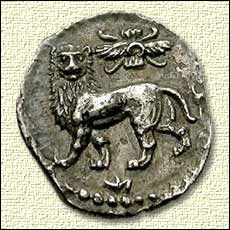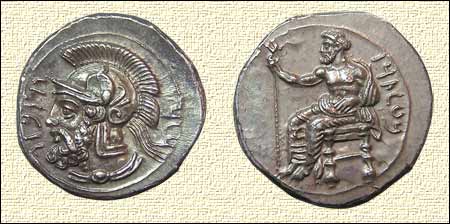It was towards the end of the 5th century when the satraps commenced striking coinage. Thereupon lotus’s appeared in subtle ways such as counterstamps indenting  coin fields such as Pamphylian staters from Aspendos as this example Pars coins displays: coin fields such as Pamphylian staters from Aspendos as this example Pars coins displays:  . Another example, this time from Myriandros Cilicia, satrap Mazaios issued obols revealing a seated dignitary whose crown leads one to presume this image might represent Persia’s king holding a lotus-tipped sceptre as well as a lotus flower. . Another example, this time from Myriandros Cilicia, satrap Mazaios issued obols revealing a seated dignitary whose crown leads one to presume this image might represent Persia’s king holding a lotus-tipped sceptre as well as a lotus flower. Satrap Tiribazos of Lydia issued staters from the Tarsos mint having Ahura-Mazda emerging from a solar disk, holding a lotus blossom. Satrap Tiribazos of Lydia issued staters from the Tarsos mint having Ahura-Mazda emerging from a solar disk, holding a lotus blossom. Ahura-Mazda was the Creator divinity for Zoroaster, thus God himself, crowned in fact on these coins Ahura-Mazda was the Creator divinity for Zoroaster, thus God himself, crowned in fact on these coins  . (In Old Persian Auramazda). Also from Tarsos he issued staters where a women kneels upon reverses with a lotus plant to the right. Obverses honour Greek goddess Athena. One particular Lycian specie shows twin triskeles encircling two dolphins, one symbol above and one below, reverses carrying what possibly was the national symbol, a triskelis. An added lotus symbol fits into the field across from the Lycian monogram “K-O”. . (In Old Persian Auramazda). Also from Tarsos he issued staters where a women kneels upon reverses with a lotus plant to the right. Obverses honour Greek goddess Athena. One particular Lycian specie shows twin triskeles encircling two dolphins, one symbol above and one below, reverses carrying what possibly was the national symbol, a triskelis. An added lotus symbol fits into the field across from the Lycian monogram “K-O”.
Above satrap Mazaios of Cilicia issued from Myriandros a lion beneath a winged solar disk. Recent archaeological data suggests Myriandros near today’s Iskenderun in Turkey, was a Phoenician colony. With pro-Phoenician Tarsos these cities exemplify religious as well as cultural freedom Persians granted. Eastern gods, Ahura-Mazda, Baal and Melkart coexisted alongside western deities : Ares, Athena, Zeus, Apollo, Aphrodite and other worthies. Another Cilician issue, a Mallos obol circa 425-385 B.C. figured with a personage or god having curved wings who presents a solar disk with both hands. Upon the reverse stands a graceful swan, wings uplifted; possibly a reference to Aphrodite. Recent archaeological data suggests Myriandros near today’s Iskenderun in Turkey, was a Phoenician colony. With pro-Phoenician Tarsos these cities exemplify religious as well as cultural freedom Persians granted. Eastern gods, Ahura-Mazda, Baal and Melkart coexisted alongside western deities : Ares, Athena, Zeus, Apollo, Aphrodite and other worthies. Another Cilician issue, a Mallos obol circa 425-385 B.C. figured with a personage or god having curved wings who presents a solar disk with both hands. Upon the reverse stands a graceful swan, wings uplifted; possibly a reference to Aphrodite.
After the latter coin issues another Egyptian campaign set an imaging and pace change in Cilicia. Payments to Greek mercenaries encharged upon a joint military command under satraps Pharnabazos and Datames (the latter was satrap of Cilicia and Cappadocia) brought about accelerated minting to which was added a Hellenic touch: a helmeted and bearded Greek god of war, Ares.(wage rates:*7)  |













